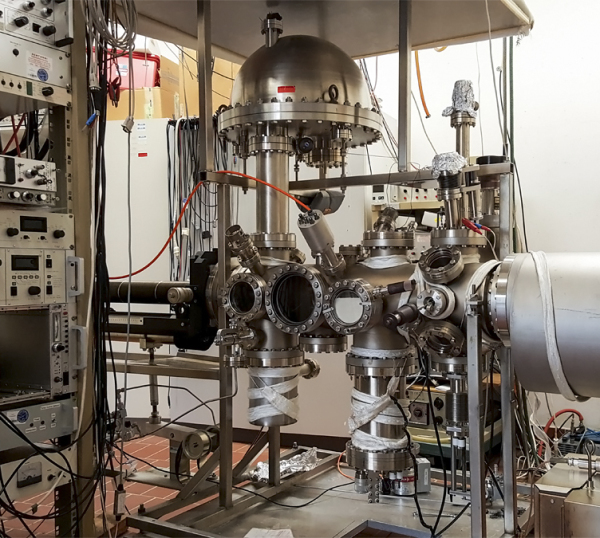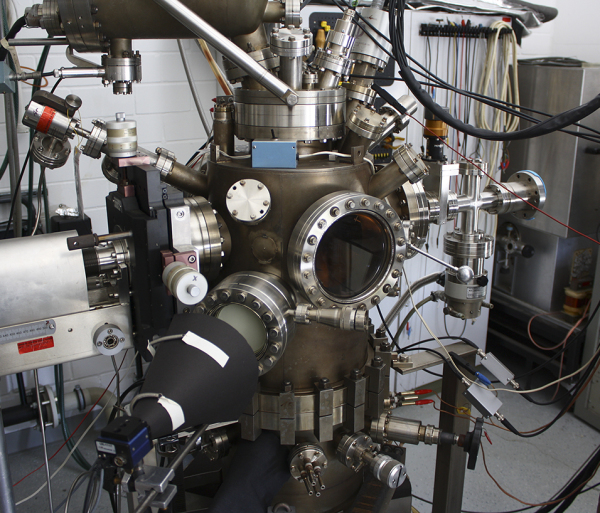Labs and equipment AG Wende
Labs
| Laboratory | Room | Phone |
|---|---|---|
| MBE/XPS Lab | MD 441 | 2974 |
| BESSY/MBE Lab | MD 442 | 2975 |
| Mössbauer Lab | MD 443 | 2940 |
| XRD Lab | MD 446 | 2956 |
| AFM Lab | MF 234 | 2185 |
| SQUID Lab | MC 233 | 2791 |
| PLD Lab | ME 054 | 2091 |
| PPMS | LN 2.46 | 8136 |
| Workshop | MD 447 | 2388 |
| Chemistry Lab | MD 463 | 2978 |
| F-Praktikum: Experiment 3.1 Mössbauer spectroscopy | MD 443 | 2940 |
| F-Praktikum: Experiment 3.2 Gamma ray spectroscopy | MC 227 | 1915 |
| F-Praktikum: Experiment 11.1 LEED-AES | MC 234 | 1629 |
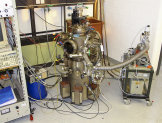
MBE
This UHV system serves exclusively for the preparation of thin films by molecular beam epitaxy (MBE). It's fitted with a load lock to transfer samples into and out of the chamber. The sample temperature can be varied between 130 and 970 K. For the computer-controlled evaporation process, up to five resistively heated evaporation cells with Al2O3 crucibles and an electron gun are available.
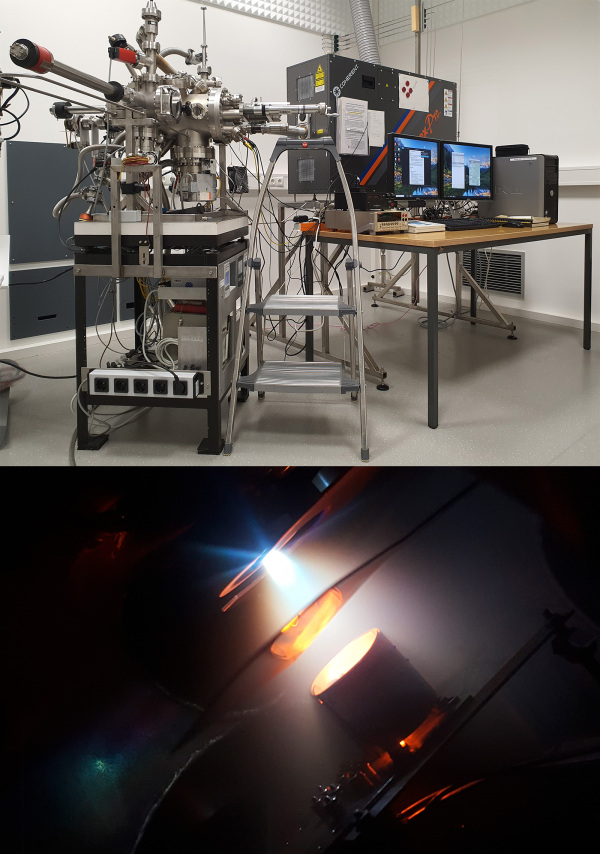
UHV-PLD
This setup is jointly operated with the AG Farle and used for the growth of thin films by pulsed laser deposition from different premade targets, using a crypton-fluorine excimer laser (KrF, 248 nm, power up to 400 mJ per pulse). This process is usually performed in a high vacuum (10-8 mbar) or pure oxygen atmosphere if oxide targets are being used. During film growth, the targets are continuously rotated and translated, to avoid excessive local heating and to achieve a homogenous evaporation of the material. The temperature of the substrate can also be controlled up to 1200 °C in manual or automatic mode. Thanks to the PC-based control of laser, sample heater, and target selection, it's possible to automatically compose multilayers from up to four different target materials. Before commencing film growth, the deposition rate can be checked by a vibration quartz monitor mounted on a movable arm, also serving as a shutter. Successfully prepared samples include multiferroic cobalt ferrite nanopillars in a barium titanate matrix. (article link)
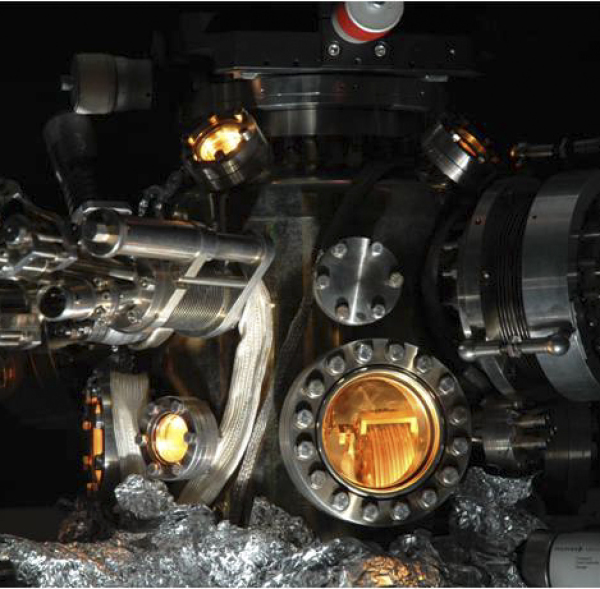
Bessy Chamber
This portable UHV chamber is designed for measurements of X-ray absorption (XAS) at synchrotron sources, especially BESSY in Berlin. As a key component, the chamber contains a water-cooled coil system. With its help X-ray magnetic circular dichroism (XMCD) can be measured in a static applied magnetic field (up to 50 mT at present).
Read more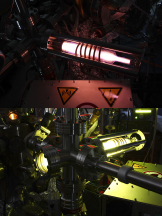
UHV Plasma Chamber
The UHV plasma chamber has been built within the scope of a bachelor thesis in our group. It is used for in situ low-pressure plasma treatment of thin films and nanoparticles. Contaminations like organic ligands or oxides are removed from the samples, which can then be directly transferred into the main chamber. In general, the plasma chamber is mounted to our BESSY-chamber but may be used together with any other UHV system that uses CF flanges. A separate pumping station allows the pressure to be controlled independently from the main chamber when mounting or cleaning samples.
The key component of the plasma chamber is a glass recipient with an external induction coil to excite the plasma inductively by an HF field. A precision valve serves as entry gate for the plasma gases, in general hydrogen or oxygen, and allows for pressure control. Typically, the pressure during the cleaning process is kept in the range of 10-2 mbar for best cleaning results.

Closed-Cycle Mössbauer Cryostat
For Mössbauer transmission measurements at low temperatures (down to 4 K) we preferably use this setup by Lake Shore Cryotronics (formerly Janis). Based on the SHI-850-5 cryostat, the integrated pulse tube cooler and helium compressor allow its operation independently of an external liquid helium supply. To avoid unwanted line broadening by the vibrations of the cooler, the sample holder is suspended on its own air-cushioned frame, which is additionally dampened by heavy weights. Thanks to the PC-based temperature and measurement controls, extensive series of temperature-dependent measurements can be performed automatically. An electromagnet has also been added to the setup, enabling measurements in fields of up to 0.8 T perpendicular to the gamma-ray propagation direction.
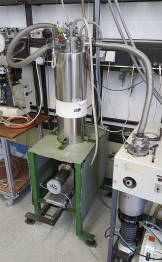
Low Temperature Mössbauer Spectrometers
We have several bath cryostats from CryoVac and Thor Cryogenics at our disposal that can be used for Mössbauer transmission measurements with either liquid helium or nitrogen. The internal setup with vacuum-insulation, an outer and an inner tank allows for long-term measurements at stable low temperatures. The sample is surrounded by helium gas to facilitate heat exchange, but the sample chamber can also be evacuated for higher temperature measurements. Thanks to sample holders with integrated electric heaters, measurements can be performed from 4.3 K up to room temperature.
In addition to Mössbauer spectroscopy, these cryostats can also be used for electrical transport measurements, thanks to the existing electrical connections of the sample holders, allowing the recording of e.g. temperature dependent resistivity curves.

10T Magnet Cryostat
This Spectromag 4000-10 magnet cryostat from Oxford Instruments was acquired in 2021 via the CRC/TRR 247 in order to enable an improved determination of the degree of inversion in spinel systems such as cobalt ferrite. With its superconducting split-pair (Helmholtz) coils, magnetic fields of up to 10 T can be applied at the sample position. This is usually done parallel to the gamma-ray propagation direction, but this setup also allows measurements with perpendicular fields. Thanks to the in-house developed automatic measurement, temperature, and magnetic field control software, a multitude of different measurement modes can be performed following pre-set patterns. The temperature control via a variable gas flow gives this setup a very high cooling power at low overall He-consumption, enabling measurements to be run at temperatures down to 1.5 K.
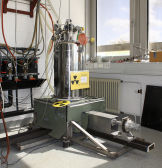
5T Magnet Cryostat
This l-He magnet cryostat from Thor Cryogenics (Project No. 77483) contains a superconducting magnet in split-coil geometry, which is able to apply a magnetic field of up to 5 T.
In standard configuration, this setup is suitable for Mössbauer transmission measurements with an applied field in either in-axis or off-axis direction. The sample temperature can be set between 2.2 K and 300 K by a system with two interconnected helium tanks, also making it possible to perform Hall measurements, as well as the recording of characteristic resistivity curves.
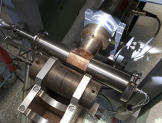
Mössbauer Oven
This vacuum oven allows us to record Mössbauer spectra at temperatures up to 800 K. Powder samples are usually pressed into flat disks, which are then mounted between two beryllium plates in a heated sample holder. The latter is inserted into a tube that's fitted with thin windows made of aluminated Mylar, allowing radiation to pass through while being able to hold a vacuum. Using an electromagnet, measurements can also be performed in an applied magnetic field perpendicular to the gamma-ray direction, at fields of up to 0.9 T.
This setup is also used for experiment 3.1 "Mössbauer Spektroskopie" of the advanced laboratory training course, to offer students an insight into this measurement method.

High-Speed Mössbauer Setup
The Mössbauer Velocity Calibrator MVC-450 from WissEl allows the calibration of the Mössbauer-drive by a laser interferometer, in contrast to the regular method of using an iron foil with known properties. This device is used for high-speed measurements, widening our range by increasing the velocity of the Mössbauer driving unit. The use is necessitated by the fact that the regular method can't offer a precise calibration for higher speeds. This also requires the use of a high-speed Mössbauer Velocity Transducer, the MVT-1000, capable of running at up to 1000 mm/s. An example of high-speed measurements consists of samples with strong temperature-depended line broadening, such as ferrofluids.
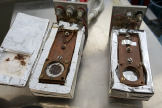
ex situ Peltier Sample Holder
These special sample holders were constructed for temperature-dependent ex situ Mössbauer measurements. Equipped with water-cooled Peliter-elements, they allow a sample to be cooled (heated) by 75 K relative to the cooling water temperature.
They are mainly used for sensitive samples that can't be measured in regular cryostats, such as ferrofluid samples with a high water content that would dehydrate in the low-pressure sample chamber of a cryostat. To minimize thermal loss, the sample is surrounded by a styrofoam mantle, with the temperature being recorded by a PT100 thermocouple. To further enhance performance, the cooling water temperature is actively controlled by an external refrigeration unit.
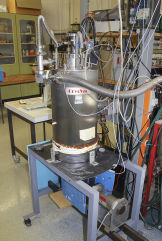
Low Temperature CEMS
For low-temperature conversion electron Mössbauer spectroscopy measurements down to 80 K, several sample holders were fitted with gas feed-throughs, which can be inserted into our existing cryostats.
For measurements down to 4.3 K, a self-built CEMS counter was installed into a CryoVac Helium bath cryostat. This counter uses a channeltron instead of the usual proportional counter. The cryostat has an inner tank filled with liquid helium and an outer tank filled with liquid nitrogen. For measurements above 4.3 K the sample can be electrically heated up to 340 K. By means of an additional electromagnet, CEMS measurements in an external magnetic field of up to 1 T can be performed at temperatures down to 80 K.
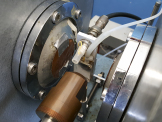
ex situ CEMS
For ex situ CEMS measurements at room temperature, a gas flow proportional counter is used as a detector due to the large solid angle covered. Helium/Methane gas flows continuously through a small proportional counter containing the absorber (sample). The conversion and Auger electrons leaving the sample surface are absorbed in the gas volume with high probability. Using an electromagnet, measurements in magnetic fields up to 1.3 T can also be performed. For measurements from RT up to 450 K, a CEMS oven is also available.

X-Ray Diffractometer
For X-ray diffraction measurements (small angle, high angle, and rocking-curves), we use a commercial θ-2θ X-ray diffractometer PW1730 from Philips. It's equipped with a horizontal goniometer, a Cu/Co/Mo anode X-ray tube, and a graphite monochromator. The measurements are performed at room temperature.
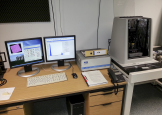
AFM
An atomic force microscope is available for the nanoscale examination of surface topography. The Q-Scope 350 is equipped with a PC-based video subsystem using a CCD camera for 90-degree tip and sample viewing, and an X-Y translation stage for sample positioning. An acoustic/vibration isolation chamber and a compressed air-dampened measurement table provide the environment needed for excellent resolution in sub-micron scan sizes. The system is capable of the following scan modes: Contact Mode, Lateral Force Mode, Intermittent Contact Mode, and Phase Mode.
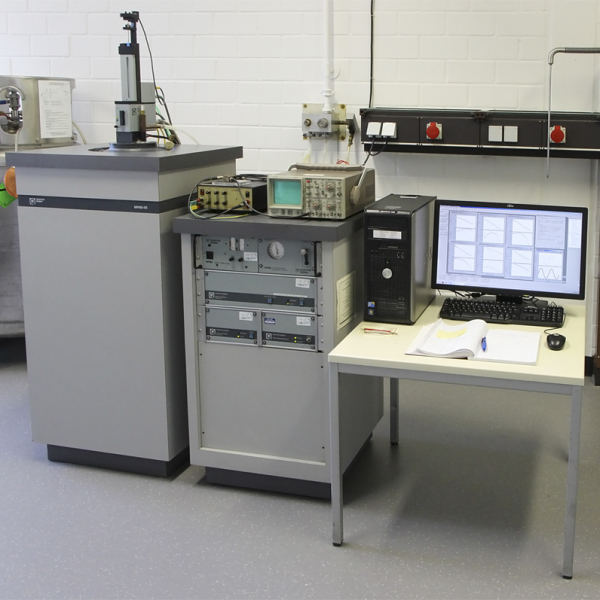
Quantum Design MPMS-5S
The Magnetic Property Measurement System from Quantum Design is a SQUID magnetometer, used for the field and temperature-dependent analysis of sample magnetization, possessing a sensitivity of up to 10-11 Am2 (10-8 emu). Its standard equipment includes a superconducting magnet, with which a magnetic field of up to ±5 T can be applied, and a temperature controller, making it possible to set the sample temperature between 4 K and 400 K.
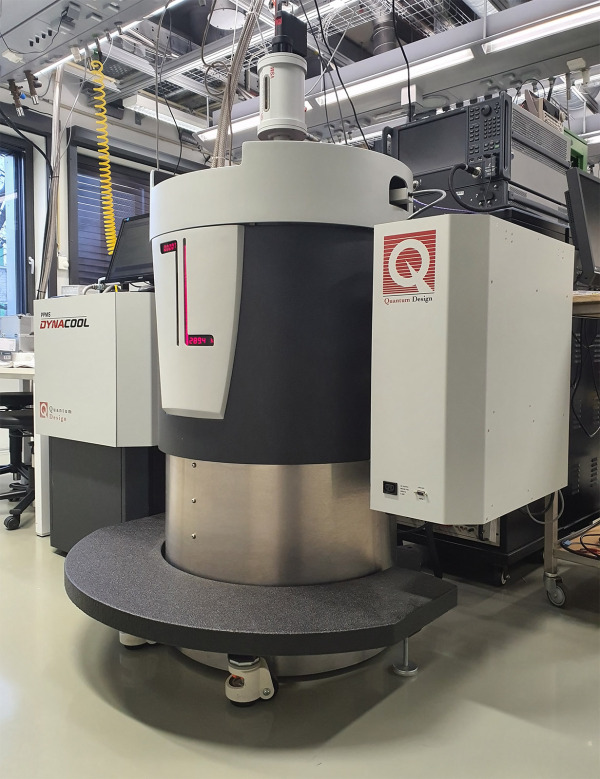
Quantum Design PPMS DynaCool
The Quantum Design Physical Property Measurement System was put into operation in June 2014 and is collectively used by four workgroups. The modular setup allows the use of a wide range of different measurement methods for electric and thermal transport, while a vibrating sample magnetometer (VSM) option facilitates very rapid magnetic measurements with sensitivities of up to 10-9 Am2 (10-6 emu). Magnetic fields of ±9 T can be applied, while the sample temperature can be set between 1.8 K and 400 K in regular operation, or between 300 K and 1000 K with the VSM oven.
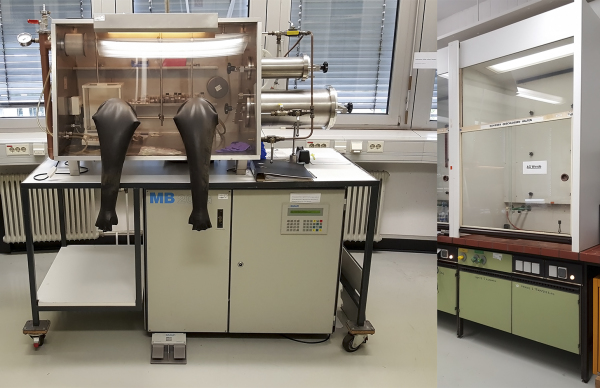
Chemistry Laboratory Glovebox and Fume Hood
For chemical work such as sample preparation and synthesis, a chemistry lab is available. It's equipped with an argon glovebox, enabling sensitive samples to be prepared and handled in an oxygen- and water-free atmosphere. For any work that might cause a release of gas, aerosol, or dust, a fume hood is also available, equipped with the usual gas, water, and electrical outlets.

